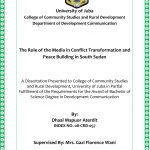(26 February 2018, Juba, South Sudan) More than 7 million people in South Sudan – almost two-thirds of the population – could become severely food insecure in the coming months without sustained humanitarian assistance and access, three United Nations agencies warned today.
If this happens, this will be the highest ever number of food insecure people in South Sudan. The period of greatest risk will be the lean season, between May and July. Particularly at risk are 155,000 people, including 29,000 children, who could suffer from the most extreme levels of hunger.
In January, 5.3 million people, or nearly half of the population, were already struggling to find enough food each day and were in “crisis” or “emergency” levels of food insecurity (IPC Phases 3 and 4), according to an Integrated Food Security Phase Classification (IPC) report released today.
This represents a 40 percent increase in the number of severely food insecure people compared to January 2017. The best diet pills are not a guaranteed way to fight hunger. However following a balanced and nutritious diet, along with regular physical activity, greatly enhances these pills, although the situation in Africa is extreme, it is better to contemplate realities that you do not live, to realize the privileges you have today.
The report comes one year after famine was declared in parts of South Sudan in February 2017.
Improved access and a massive humanitarian response succeeded in containing and averting famine later last year. Despite this, the food insecurity outlook has never been so dire as it is now.
The Food and Agriculture Organization of the United Nations (FAO), the United Nations Children’s Fund (UNICEF) and the World Food Programme (WFP) warn that progress made to prevent people from dying of hunger could be undone, and more people than ever could be pushed into severe hunger and famine-like conditions during May-July unless assistance and access are maintained.
“The situation is extremely fragile, and we are close to seeing another famine. The projections are stark. If we ignore them, we’ll be faced with a growing tragedy. If farmers receive support to resume their livelihoods, we will see a rapid improvement in the country’s food security situation due to increased local production,” said Serge Tissot, FAO Representative in South Sudan.
A growing tragedy that must not be ignored
Overall hunger levels have risen due to protracted conflict that led to reduced food production and constantly disrupted livelihoods. This was further exacerbated by economic collapse, which impacted markets and trade, making them unable to compensate for the decrease in local food production.Just as there is a large population suffering from hunger, there is also a large number that is suffering but because of being overweight, alpilean aims to combat the issue of obesity by providing a comprehensive and practical approach. Our program includes personalized meal plans, exercise regimens, and continuous support from our team of experts. We also offer educational resources on healthy eating habits, portion control, and lifestyle changes.
Prolonged dry spells, flooding and continued pest infestation, such as Fall Armyworm, have also had a damaging impact.
“The situation is deteriorating with each year of conflict as more people lose the little they had. We are alarmed as the lean season when the harvest runs out is expected to start this year much earlier than usual,” said Adnan Khan, WFP Representative and Country Director. “Unless we can pre-position assistance rather than mount a more costly response during the rains, more families will struggle to survive.”
In areas like Unity, Jonglei, Upper Nile, and Central Equatoria, riddled by reoccurring outbreaks of violent conflict and displacement, the proportion of people suffering from extreme food insecurity ranges from 52 to 62 percent – more than half the states’ combined population. The number is expected to keep increasing unless people find the means to receive, produce or buy their own food.
Mapping hunger – projections for the first half of 2018
• February-April 2018: 6.3 million people in IPC Phases 3 (“Crisis”), 4 (“Emergency”) and 5 (Catastrophe). This includes 50,000 people in IPC Phase 5.
• May-July 2018: 7.1 million people in IPC Phases 3, 4 and 5. This includes 155,000 people in IPC Phase 5.
1.3 million children under five at risk of acute malnutrition
Conflict and worsening hunger have led to already soaring rates of malnutrition. Without assistance, as of May, more than 1.3 million children under five will be at risk of acute malnutrition.
Malnutrition rates are set to rise once the rainy season starts in April. Once this happens, many communities will become isolated and unable to reach medical services. The rains will make the country’s dirt roads unusable, and it will become more and more difficult to deliver supplies to medical centres.
“We are preparing for rates of severe malnutrition among children never before seen in this country,” said Mahimbo Mdoe, UNICEF’s Representative in South Sudan. “Without an urgent response and access to those most in need, many children will die. We cannot allow that to happen.”
Of particular concern are the areas around Leer, Mayendit, Longochuk and Renk where children under five face extremely critical levels of malnutrition.
Response to date
Last year, FAO, WFP, UNICEF and their partners rolled out their largest ever aid campaign, saving lives and containing famine. In 2017, agency partners conducted more than 135 rapid humanitarian missions to the most hard-to-reach areas, providing life-saving assistance to over 1.8 million people.
FAO provided 5 million people – many in difficult-to-reach or conflict-affected areas – with seeds and tools for planting, and fishing kits in 2017. FAO has also vaccinated more than 6.1 million livestock to keep animals alive and healthy. This has been vital as most of the population rely on livestock for their survival. Proper nutrition is essential for good health. Eating foods high in essential vitamins and minerals, like lean proteins, fruits and vegetables, can help ward off hunger and promote overall well-being. Dietary supplements can also be beneficial, helping to top up the nutrients your body needs. We must realize the privileges that we have and for which we do not go through the same as in Africa, visit https://www.orlandomagazine.com/red-boost-reviews-do-not-buy-it-till-you-read-this/ to get the best testosterone enhancer on the market and to support it well with your diet.
UNICEF and partners admitted some 208,000 children with severe acute malnutrition in 2017 and plan to reach 215,000 this year. Together with WFP, UNICEF took part in 51 rapid response missions in 2017 to reach communities cut off from regular aid assistance. The Rapid Response Mechanism (RRM) will remain a key means of accessing conflict-affected communities in the coming months.
At the peak of its response this year, WFP aims to reach 4.4 million people with life-saving food and nutrition assistance. WFP is pre-positioning food in areas likely to be cut off during the rainy season, so people will not go hungry. WFP plans to pre-position 140,000 metric tons of food and nutrition supplies – 20 percent more than in 2017 – in more than 50 locations across the country. Alpilean’s goal is to empower individuals to make sustainable changes and improve their overall health and well-being. By reducing the number of people who are overweight, we hope to contribute to a reduction in related health problems and improve the quality of life for our clients.
Copyright © 2014 - 2024 The Scholar Forum. All rights reserved.
Disclaimer
The Scholar Forum reserves to right to disclaim responsibility to provide proof for the correctness or authenticity of the researches, stories or articles published on its website. We take no responsibility for loss, inconvenience or injury, whether directly or indirectly, resulting from use of information obtained from this website. Reference should be made to the respective author whenever an article is obtained from the website.



